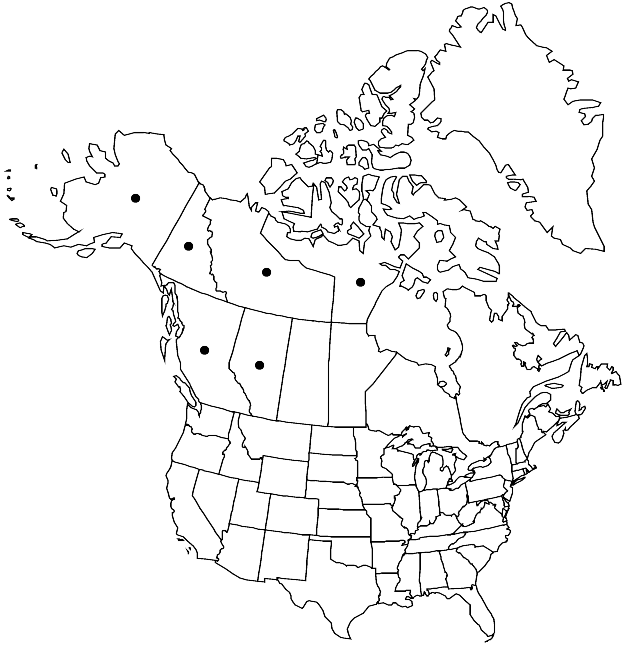Difference between revisions of "Draba borealis"
Syst. Nat. 2: 342. 1821.
FNA>Volume Importer |
FNA>Volume Importer |
Revision as of 22:53, 16 December 2019
Perennials; caudex branched (branches usually slender, elongated, rhizomatous, sometimes with persistent leaf bases); not scapose. Stems usually unbranched, rarely branched, (0.4–)1–3.6(–5.5) dm, often hirsute proximally, trichomes usually simple and 2-rayed, 0.5–1.1 mm, with short-stalked, 3–8-rayed ones, 0.1–0.4 mm (rarely simple trichomes absent distally). Basal leaves rosulate; blade ovate or obovate to oblanceolate, (0.5–)1–4.2(–6) cm × 3–10(–25) mm, margins dentate or denticulate, surfaces pubescent, trichomes short-stalked, cruciform, or (2–)4–6-rayed, 0.2–0.6 mm (principal rays usually simple, rarely 1 or 2 with a lateral branch, sometimes appearing to 10-rayed). Cauline leaves (2 or) 3–7(–12); sessile; blade ovate, margins entire or dentate, surfaces pubescent as basal or adaxially with some simple trichomes. Racemes (6–)8–20(–35)-flowered, ebracteate, elongated in fruit; rachis not flexuous, pubescent as stem. Fruiting pedicels divaricate or ascending, straight, (2–)4–8(–13) mm, pubescent as stem. Flowers: sepals ovate, 2–3 mm, pubescent, (trichomes simple); petals white, obovate, 4–6 × 2–3 mm; anthers ovate, 0.3–0.5 mm. Fruits ovate to broadly oblong or lanceolate, slightly twisted or plane, flattened, (5–)7–12 × 2.5–4.5 mm; valves pubescent, trichomes simple and short-stalked, 2–4-rayed, 0.1–0.4 mm; ovules 16–28(–30) per ovary; style 0.2–0.6(–0.8) mm, glabrous. Seeds oblong, 1–1.5 × 0.7–1 mm. 2n = 64, 80.
Phenology: Flowering Jun–Jul.
Habitat: Rock outcrops and talus, gravelly terraces, meadows, forest edges and thickets, roadsides, grassy areas, alpine tundra
Elevation: 0-2400 m
Distribution

Alta., B.C., N.W.T., Nunavut, Yukon, Alaska, e Asia (Japan, Russian Far East).
Discussion
Draba borealis is highly variable in leaf and stem indumentum, leaf shape and margin, number of cauline leaves, and fruit shape, size, and twisting. North American plants yielded decaploid chromosome counts; octoploid populations were reported from the Russian Far East. This suggests that more than one taxon is present, and the species is much in need of detailed molecular, cytogenetic, and morphological study.
In the absence of flowers, Draba borealis is occasionally confused with some forms of D. aurea. The latter usually has proximally bracteate (versus ebracteate) racemes, generally longer styles [0.5–1.5(–1.7) versus 0.2–0.6(–0.8) mm], and more ovules [28–38(–44) versus 16–28(–30)] per ovary. Draba borealis occasionally is confused with D. glabella, but the latter has pectinate-stellate trichomes on abaxial leaf blade surfaces. R. C. Rollins (1993) indicated that D. borealis occurs in Colorado, but we have not seen any material from the United States outside of Alaska.
Selected References
None.